For the last few weeks, my 6 artichoke plants (8? 10? More? They’ve multiplied so much that I’ve lost count) have been going off. Each plant bears beautiful spiny buds of the Purple of Romagna variety, an Italian heirloom that’s said to be more tender than the typical green globe.
I love to grow artichokes (Cynara cardunculus var. scolymus) because they’re ornamental and edible. I wasn’t much of an artichoke eater until I had my own plants—I just liked the way they looked.
They were exotic and easy to grow and I soon found the stems just as scrumptious as the hearts.
Read more: Anatomy of an Artichoke
They’re great for landscaping because in ideal growing conditions, the root system can live for up to five years and produce countless new plants each year—a bonus for a lazy garden. (In colder climates, artichokes are grown as annuals unless overwintered in containers indoors.)
In my coastal climate, which stays fairly mild year-round (not too hot in the summer and not too cold in the winter), artichokes are perennials.
They die back (become dormant) over winter and re-bloom in spring. Throughout the warmer months, my plants are constantly sprouting new buds and sending up shoots that then grow into new plants.
Each plant terminates in a large, beautiful bud, with smaller buds growing from the leaf nodes.
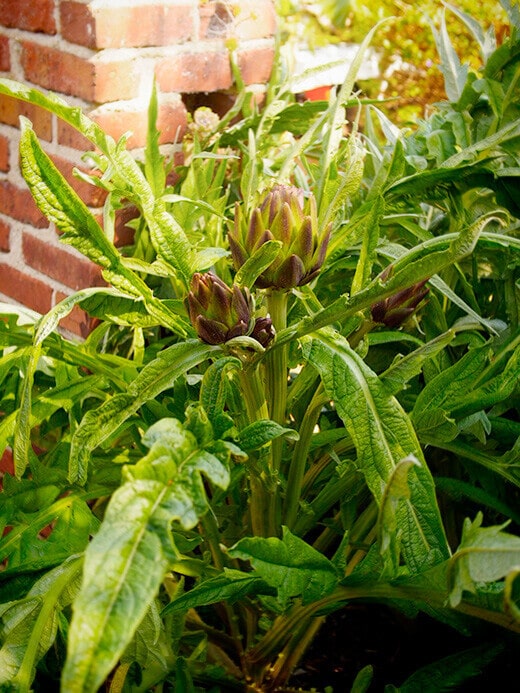
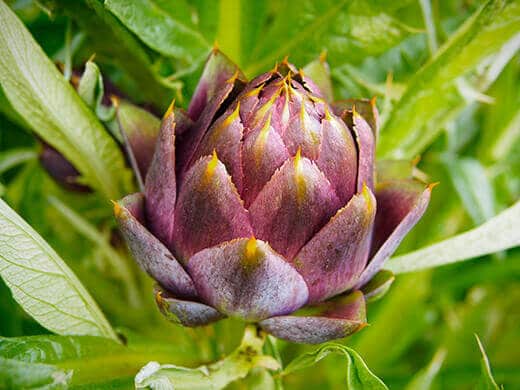
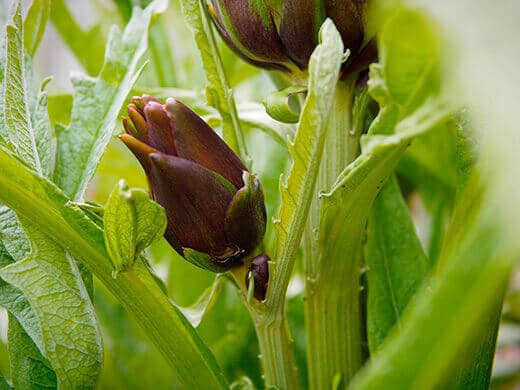
Despite being Purple of Romagna artichokes, not all of mine turn purple. Some are tinged in green, and that often happens when you grow artichokes from seed. The seedlings don’t always grow “true to parent”—that is, bearing the classic genetic traits of their variety.
The only way to ensure a plant with desirable traits (such as color and size) is to dig and divide a mature plant exhibiting those traits, as its offshoots will share that same genetic code.
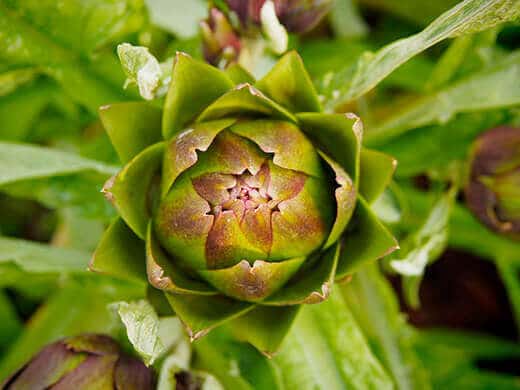

One plant will give me a dozen delicious artichokes before it’s spent, with each subsequent artichoke becoming smaller in size.
Try this: Steamed Artichoke with Pesto Crumb
If given plenty of room to spread (and divided regularly so new shoots aren’t crowded), it’s not uncommon to harvest a couple dozen artichokes from just a single plant. Even in my limited space, my artichoke plants grow to about 3 feet wide by 3 feet high.
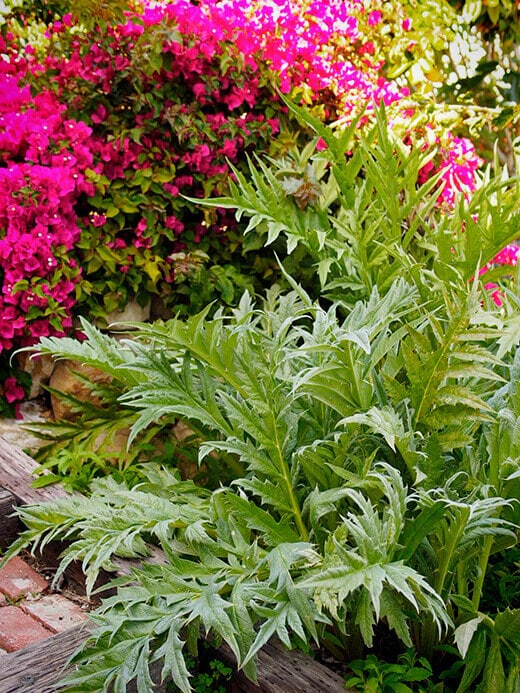
Toward the end of the season when I can’t possibly eat anymore artichokes, I like to leave a couple of buds on the plant to bloom.
Related: How to Trim an Artichoke (Or… How to Get to the Good Stuff Right Away)
Artichoke flowers are an amazing sight with bursts of bright purple florets, and they’re highly attractive to bees and other pollinators.
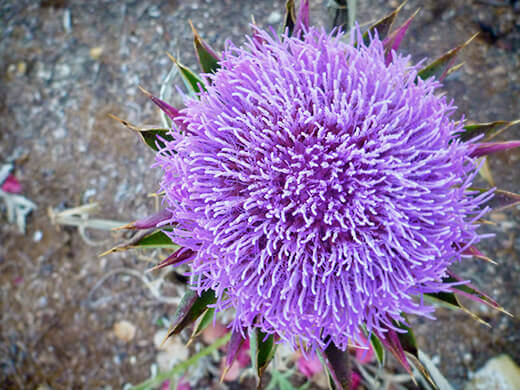
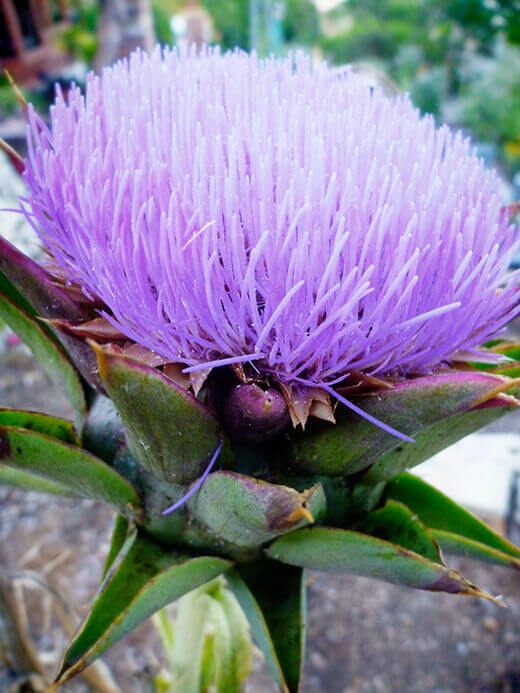
Once the show is over, you can simply cut the plant down to the ground and wait for next season’s stunners to spring up.


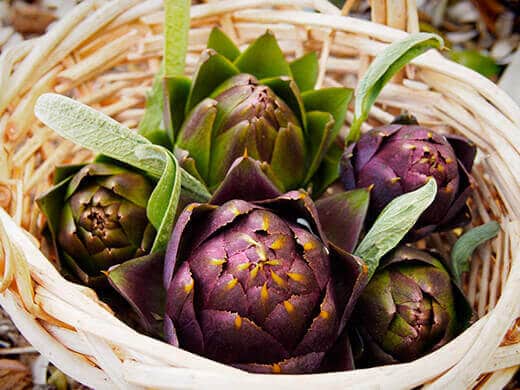













So is Purple of Romagna different than Romanesco? Romanesco is from the year 1400 and is a purple globe, and if these are all pics of Romagna they don’t look like globes. Sorry for the stupid question, but I’m new to artichokes and trying to pick just 1 to grow. Thanks!
Correct, Purple of Romagna is a different variety as it is NOT a globe artichoke.
Hi! When you need to split them, do you recommend a certain time? Right now they are way overcrowded but everything is too large for me to get under there and transplant them (they are so dramatic for a few days too aren’t they? lol). I was wondering if I could wait later – Arizona summer usually makes them die down and go dormant I think.
I split them after they’ve died back, and when the new shoots are only a few inches tall.
Your purple artichokes are stunning!!! I too am obsessed with all produce that is purple, and have been trying to slowly replace my globe artichokes with purple ones. The mature ‘purple’ plants were from Territorial seed (“violetta”) and only one of 4 plants is purple/green. As you mentioned, they really are more tender than globes, so I still prefer them even if most are green!
Inspired by your photos, I’m starting some “purple of romagna’ now, and hoping they might have a higher chance of purple-ness.
Do you know if nurtrients affect how purple they are? The only one I have that is purple will show different gradients for different crops- sometimes being mostly purple, and sometimes almost entirely green.
Oh! And these plants are GREAT fresh produce for my goats and horse! (They LOVE them!) When they are done fruiting, I feed whole plants to the critters a few a day.
Nutrients don’t make a difference in how purple or green these artichokes turn… I have plants growing in the same space that are all purple or green-to-purple gradient. I think it’s all in the luck of the seed you have. But when your strongest purple plants start dividing, you can pull up those shoots and transplant them.
You prepare them the same way you’d prepare a broccoli stem or an asparagus stem… Just peel the outer layer if it seems fibrous, then steam, saute or boil them. They can be as tender or as crisp as you want. I only eat the first couple inches of stem though; the bottom part of the stem (near the base) is much too thick to be edible.
I steam them and dip the petals in butter. YUM! It’s also good (In my opinion) to add some balsamic vinaigrette to the butter!
Such beautiful plants – great photos. I didn’t realize how productive they were! You mentioned that you eat the stems as well as the hearts – how do you prepare those?
– Sarah | gosprout.it
RT @theGardenBetty: An Italian heirloom variety from @rareseeds: Purple of Romagna Artichokes http://t.co/HB11PJH53t #gardenchat #gardening
RT @theGardenBetty: An Italian heirloom variety from @rareseeds: Purple of Romagna Artichokes http://t.co/HB11PJH53t #gardenchat #gardening
RT @theGardenBetty: An Italian heirloom variety from @rareseeds: Purple of Romagna Artichokes http://t.co/HB11PJH53t #gardenchat #gardening
Blogged on Garden Betty: Purple of Romagna Artichokes http://t.co/qSe3f2m1Ur < TY for RT! @Angry_Saguaro
Even if you don’t like to eat them, they make lovely landscaping plants. Purple of Romagna Artichokes http://t.co/uCq1HAZEv2 #gardenchat
Exotic, easy to grow, with stems just as delicious as the hearts. Purple of Romagna Artichokes http://t.co/DFP0DtUNFa #gardenchat #gardening
This Italian heirloom said to be more tender than the standard green globe: Purple of Romagna Artichokes http://t.co/mKHXUlnVAD #gardenchat
RT @theGardenBetty: It’s artichoke season! Here’s what I’m growing in my backyard: Purple of Romagna Artichokes http://t.co/G66eh4dj9g #gar…
RT @theGardenBetty: It’s artichoke season! Here’s what I’m growing in my backyard: Purple of Romagna Artichokes http://t.co/G66eh4dj9g #gar…
It’s artichoke season! Here’s what I’m growing in my backyard: Purple of Romagna Artichokes http://t.co/G66eh4dj9g #gardenchat #gardening
Siobhan Corr liked this on Facebook.
I had no idea artichokes were so beautiful! That plant looks like a sea anemone when it blooms. wow
An Italian heirloom variety from @rareseeds: Purple of Romagna Artichokes http://t.co/HB11PJH53t #gardenchat #gardening
Jun Iguchi liked this on Facebook.
Garden Betty, I just love your blog. These pictures are beautiful. I need to see if artichokes will grow in my NC planting zone!
Thank you! I believe artichokes are perennials from zones 7 and up… any colder and they’re treated as annuals, or should be grown in large containers to be overwintered indoors.
RT @theGardenBetty: Blogged on Garden Betty: Purple of Romagna Artichokes http://t.co/qSe3f2m1Ur
Randall S. Winkler liked this on Facebook.
Enjoy
Purple of Romagna Artichokes:
For the last few weeks, my 6 artichoke plants (8? 10? More? They’ve multiplied … http://t.co/TLZHPONC3L
Blogged on Garden Betty: Purple of Romagna Artichokes http://t.co/qSe3f2m1Ur